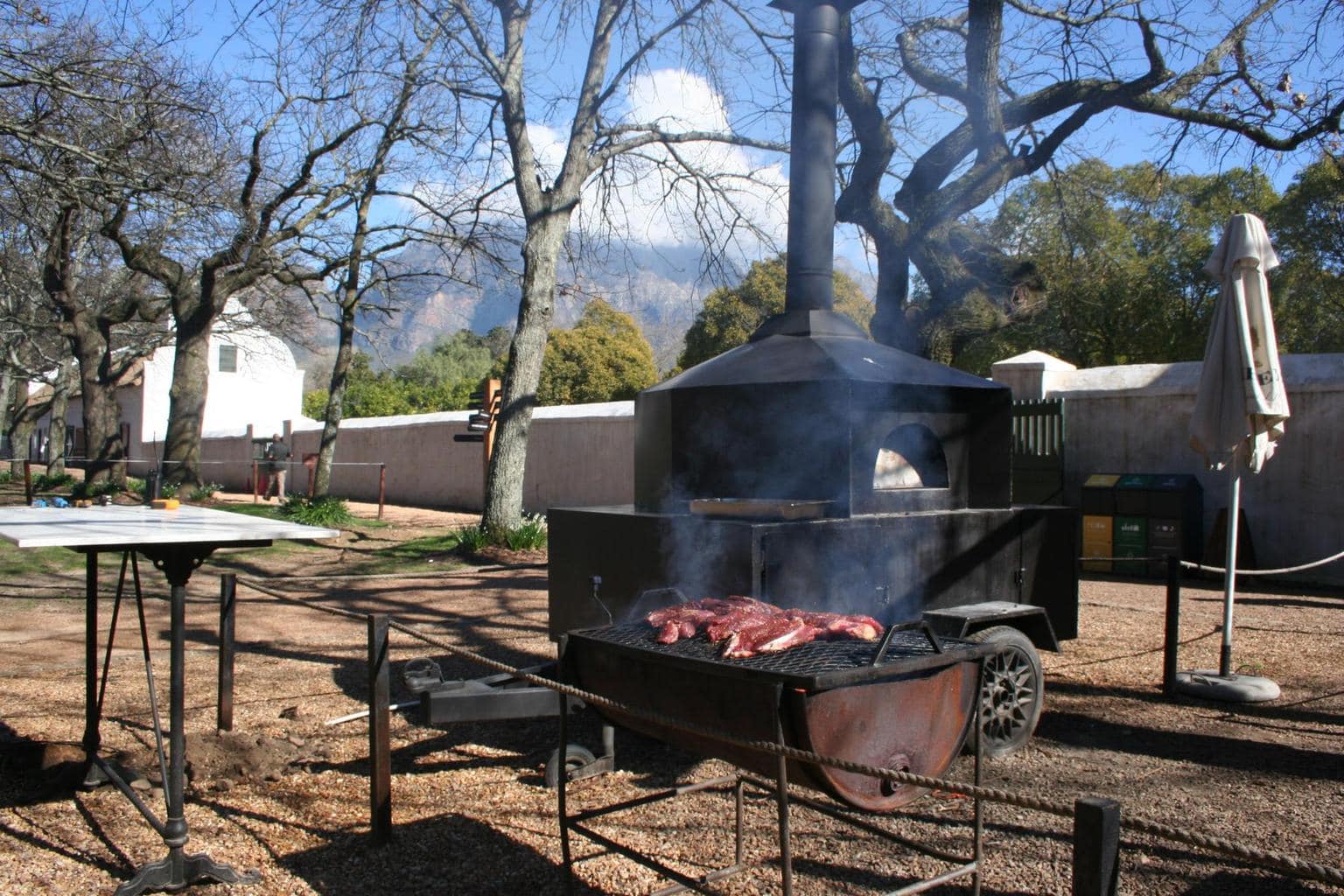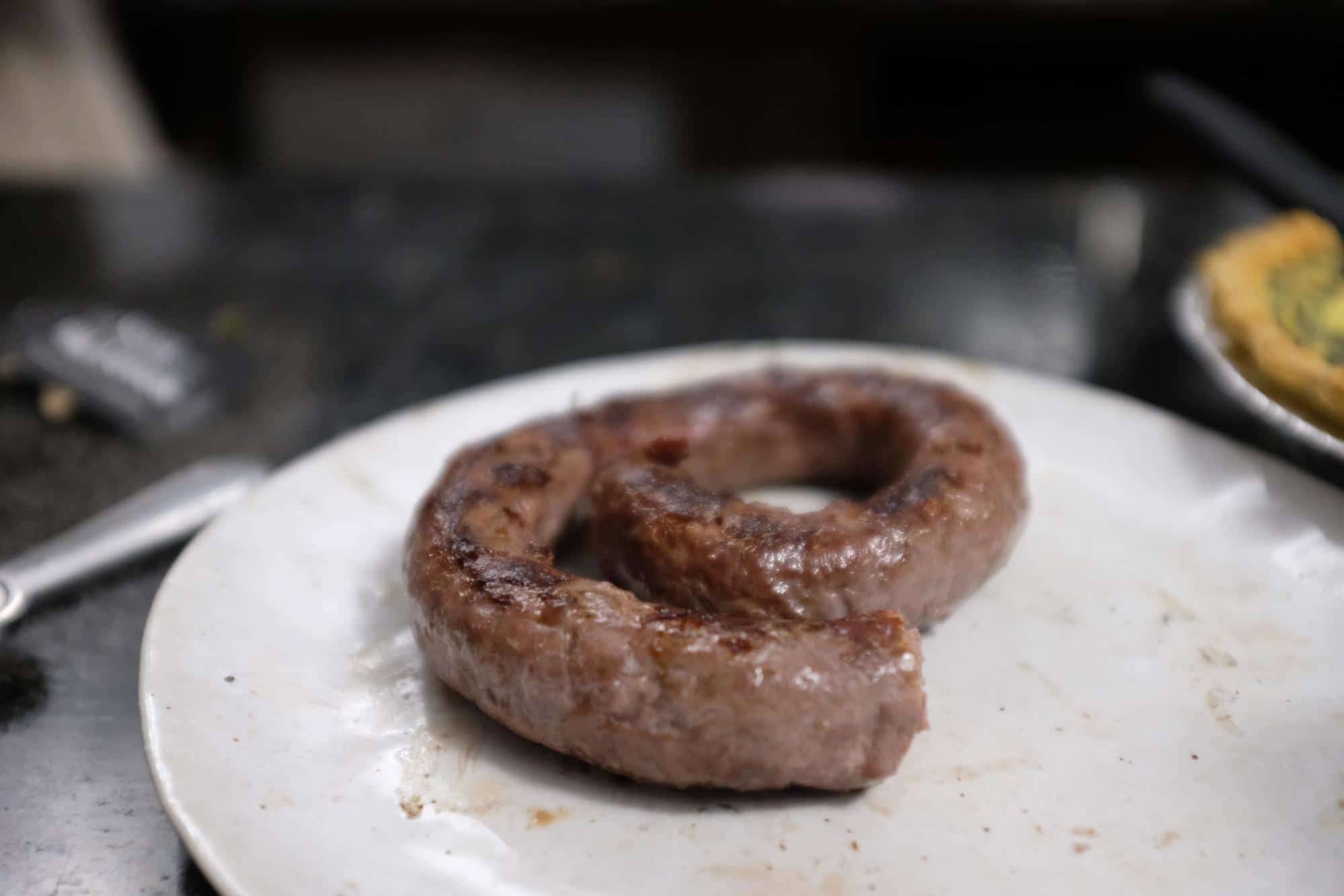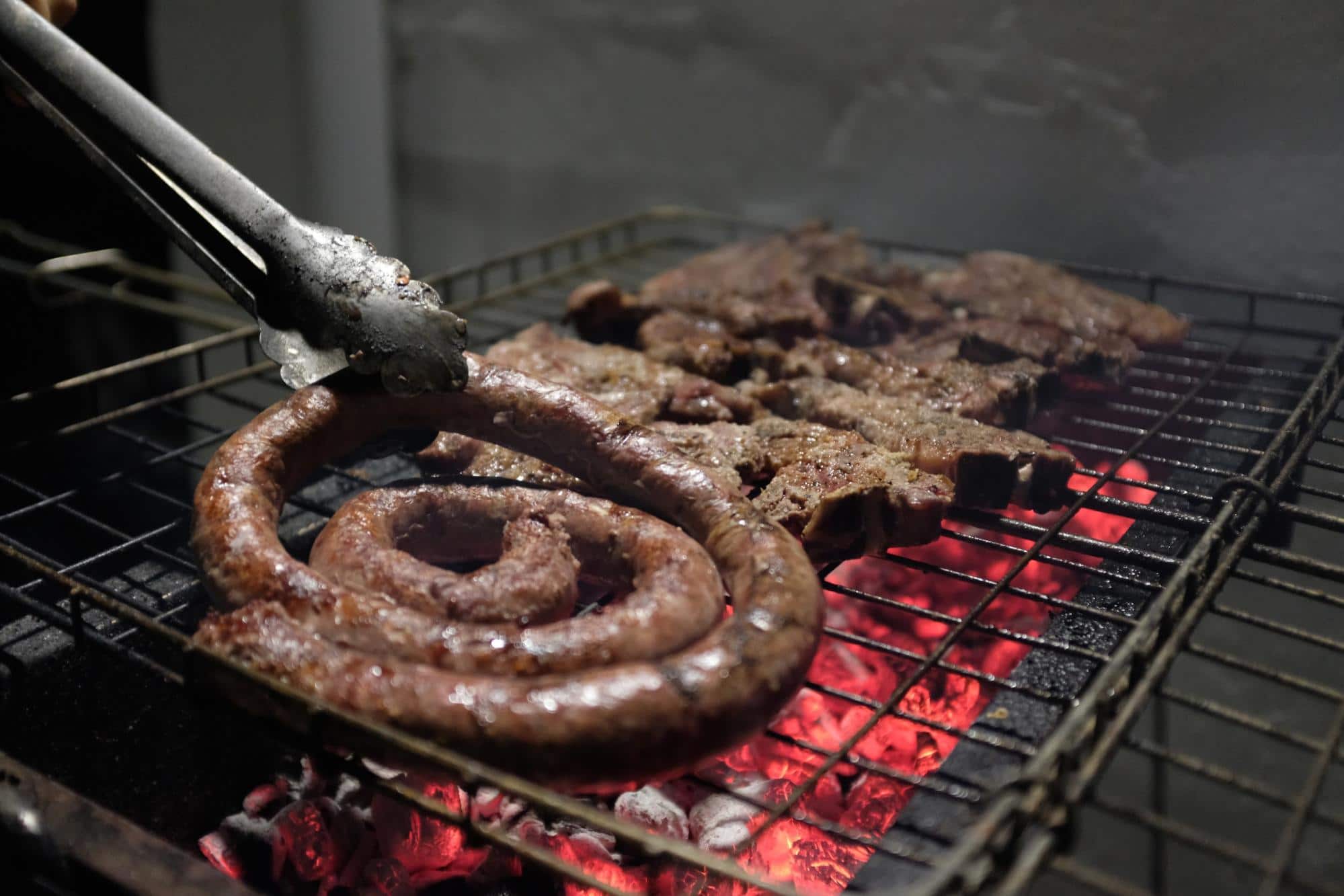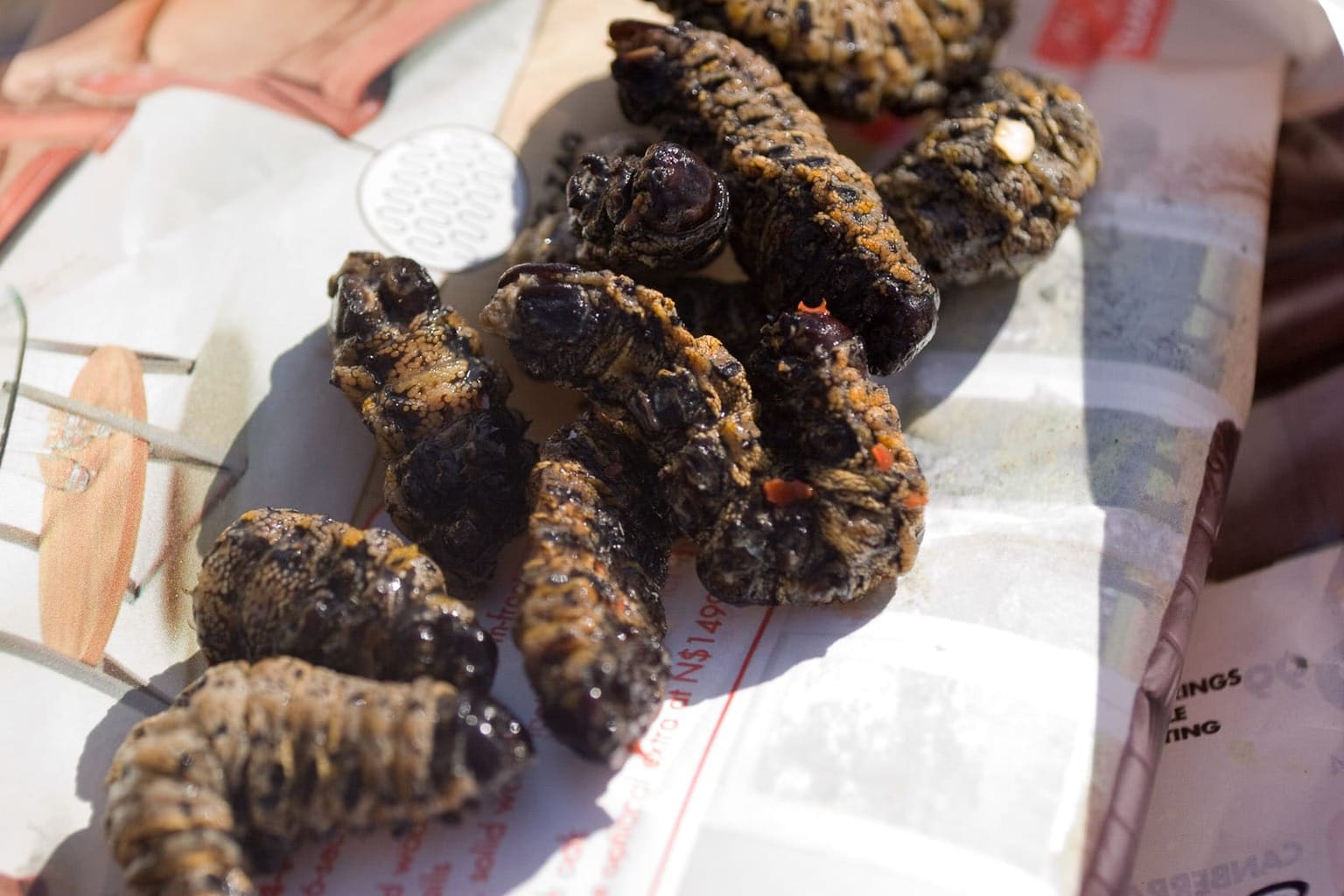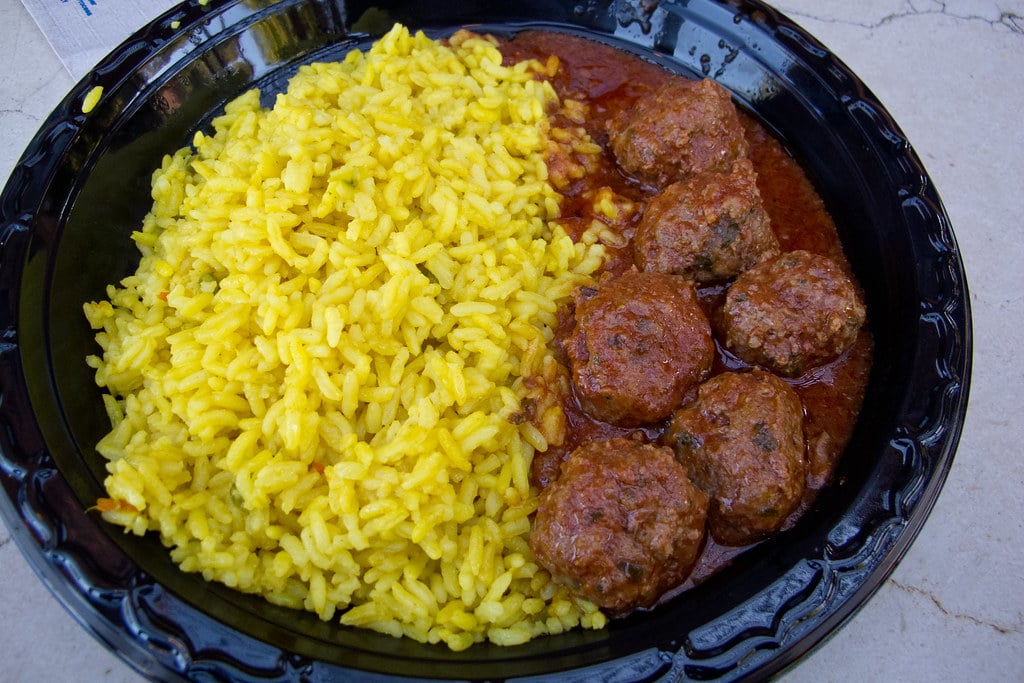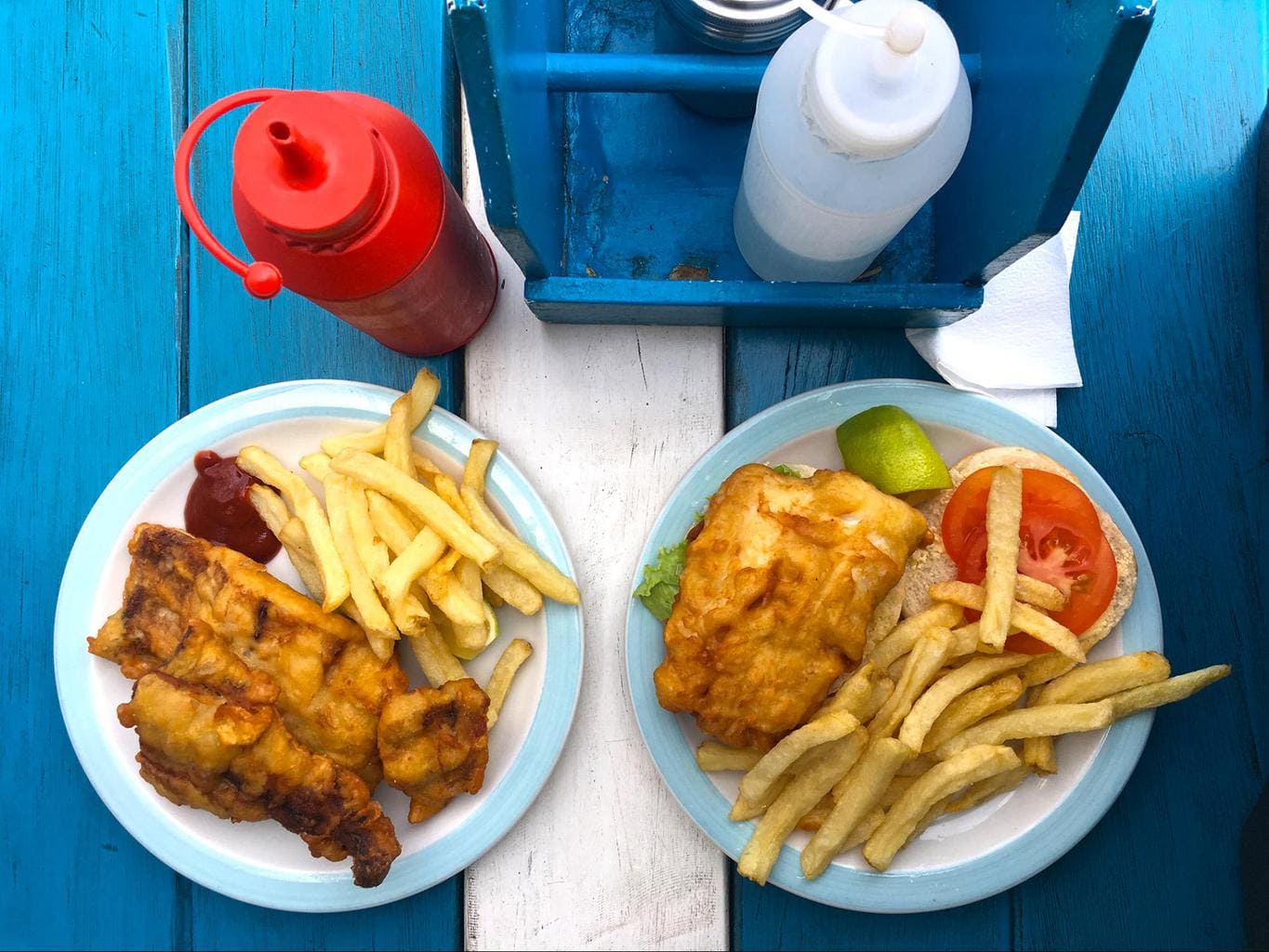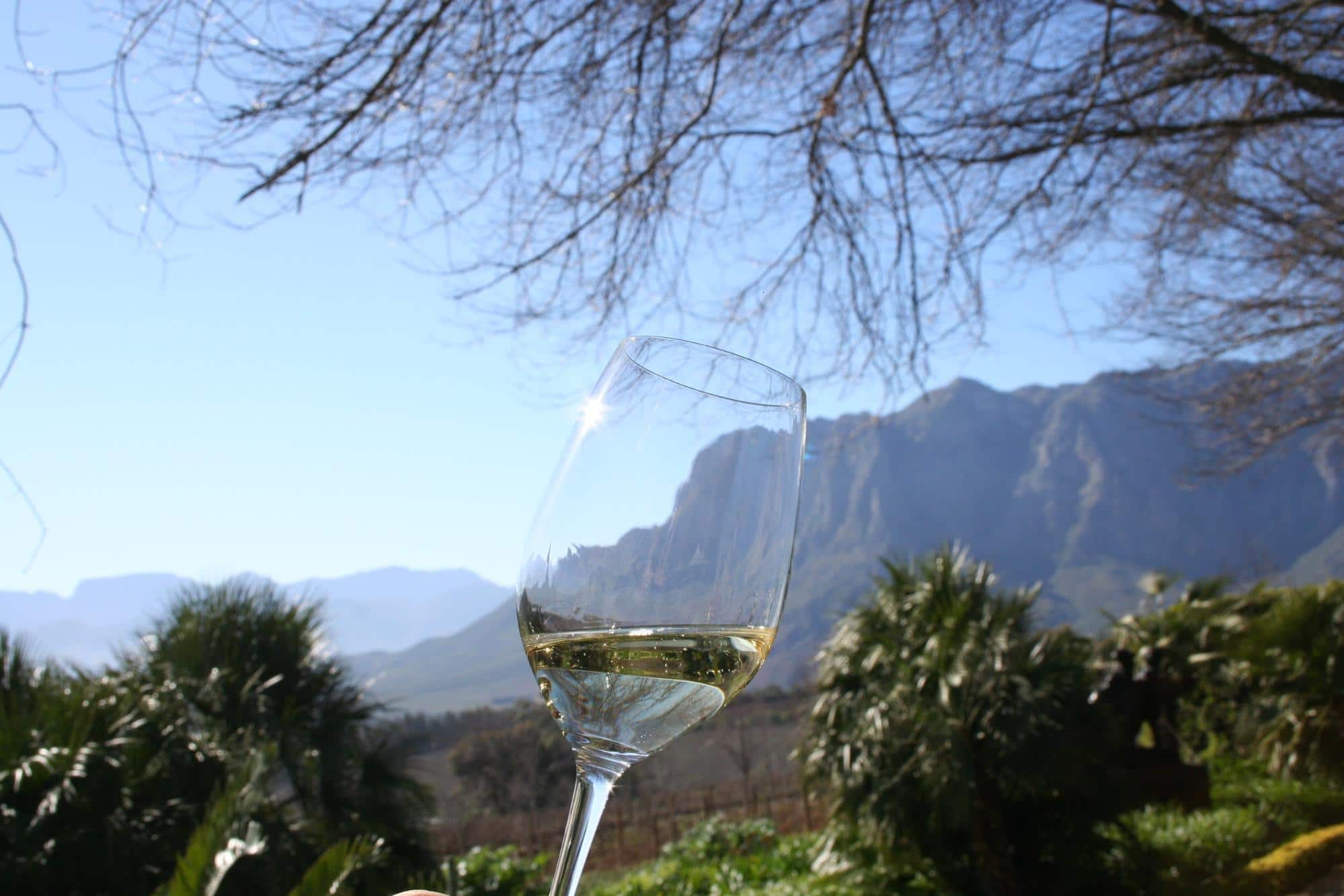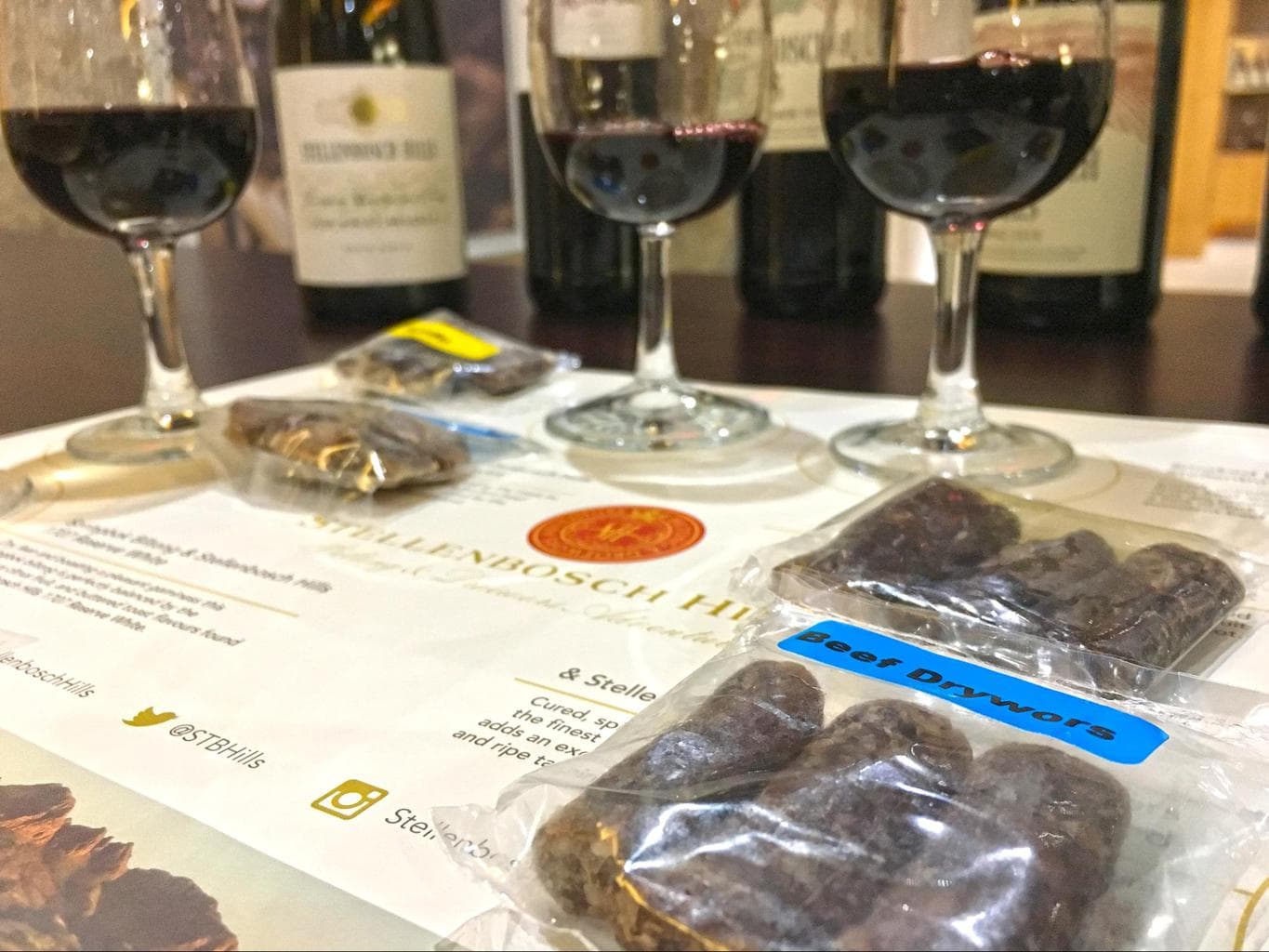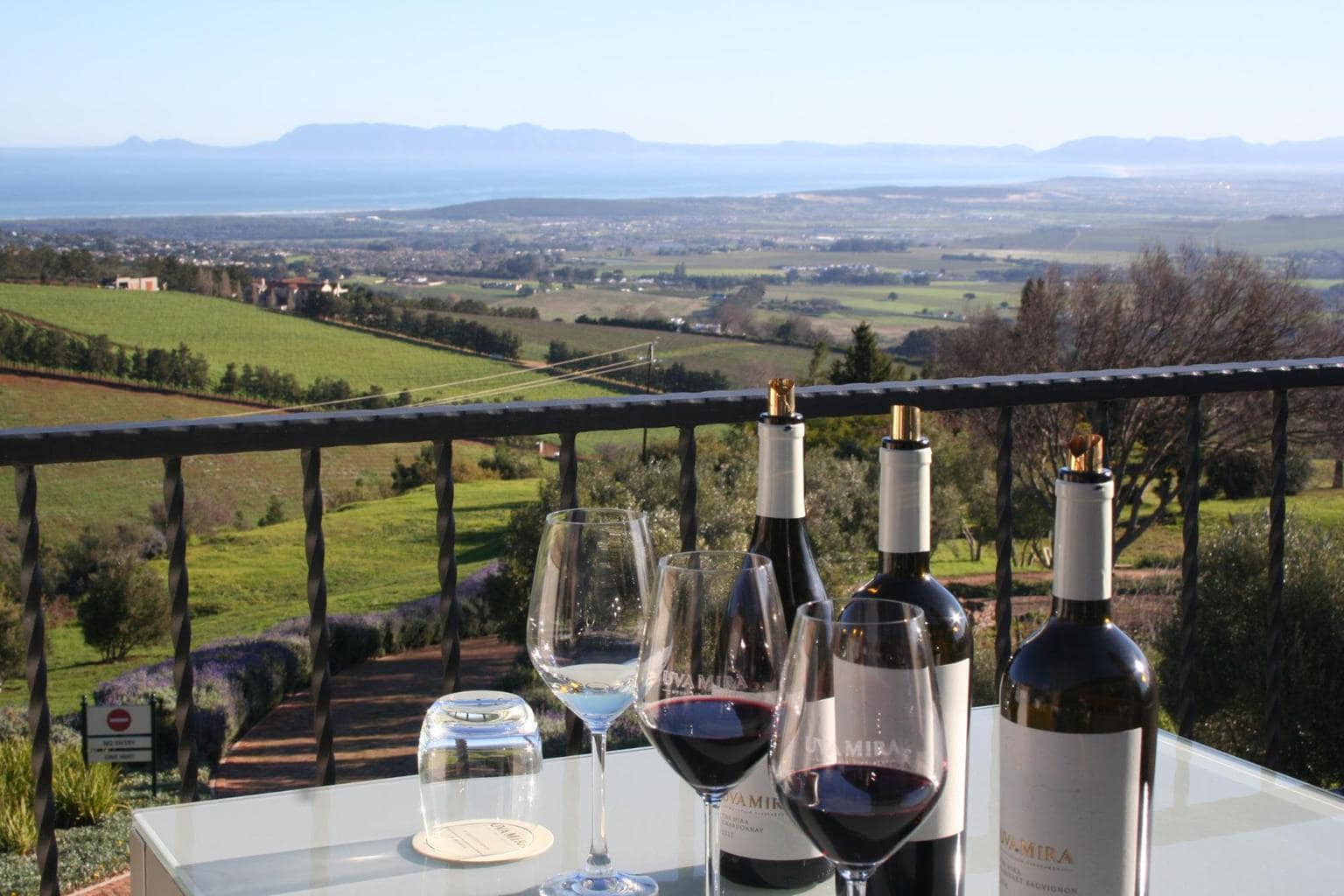This article was first published in September 2019 and was updated in June 2020.
Food in South Africa showcases not only the country’s diversity, but also its tumultuous past. There are influences of traditional South African food flavors and methods with a touch of British, French, German and Dutch, sprinkled with Portuguese.
The country is nicknamed the Rainbow Nation for a good reason as it is a melting pot of different ethnicities, cultures, religions and tribes. And where you have a multicultural society brought about by colonisation, you always have the most diverse and unique food. Just like Macau, Bangladesh, Azerbaijan or any of the Balkan countries such as Albania, Macedonia or Montenegro.
The cuisine of the “Cape Malay” is the perfect example with influences from Indonesia and Malaysia that were brought into Cape Town by Dutch settlers during the slave trade in the 17th and 18th centuries.
Beyond the influence of colonialism there is also the local flavors coming from the indigenous people of Africa like the Nguni tribes of the Zulu and Xhosa. And even before them the herding of cattle, cooking of sorghum and fermentation of milk by the Khoisan.
So, what can you expect in a typical South African dish? Read on to find out all about this interesting cuisine and then get stuck into our list of the best South African food to eat on your trip to the country.
Influences from around the world
The story of South African food is one of blending, borrowing and adapting. European and African cooking techniques combined with Eastern spices have brought a real melting pot into South African cuisine, quite literally!
It starts with the indigenous people of South Africa, the Khoisan, who were hunter-gatherers. It was later when the north Africans arrived that they introduced modern agriculture and foods such as corn (locally called mealies), squash and sweet potatoes.
The Zulu tribes brought mealie-meal (locally known as pap) to the country along with a diet of meat and vegetables.
While the Khoisan had been curing meat for centuries, European settlers introduced a more sophisticated curing process. Adding spices from the East and vinegar to create the dried meat called biltong (similar to beef jerky).
South Africa’s history is one of colonisation, slavery and segretion. It is no wonder that one can see various influences from around the world in a single dish. There are several outside protagonists that shaped the food in South Africa, beyond the indigenous people.
European influences
European influence in South Africa started with Portuguese explorer Bartolomeu Dias, who landed in the Cape of Good Hope (present day Cape Town) in 1488. And with his discovery, Europe had found a new trading route to India and the Far East (although he didn’t make it all the way to India on his voyage).
His contemporary, Vasco da Gama, first set foot in the Cape of Good Hope in 1497. He then traversed Africa and landed in India which solidified the Europe-Africa-East trade route. The major input the Portuguese had on South African food was the introduction of chilies which helped to create the famous peri-peri sauce.
During the 1500’s the British first set foot on the Cape en route to India and the East, namely Admiral Francis Drake and James Lancaster who describes a trade with the Khoisan and in it the wonderful woolless sheep.
A few Dutch ships traversed the tip of Africa, but it wasn’t until 1652, with the arrival of Jan van Riebeeck, that a refreshment station was erected. With the arrival of the Dutch, gardens were planted along with new crops like pumpkins, watermelons, cucumbers, pineapples, and potatoes.
As the Cape of Good Hope was a midway trading point between India and Europe, it was also a fantastic melting pot of new aromas and spices.
After van Riebeeck landed, the company he worked for, The Vereenigde Landsche Ge-Oktroyeerde Oost-Indische Compagnie (VOC), stated that the indigenous population was not to be enslaved. He then requested slaves to be brought from Asia for manual labor.
The slaves brought with them an entirely new cooking method that gave flavor to the often bland European cooking styles. The Dutch added the spices from Malaysia and Indonesia and the cooking methods of the Khoisan, like grilling over an open flame, to create a new type of South African food known as “Cape Dutch” cuisine.
The Cape Malay cuisine is a natural extension of Cape Dutch food. More on the Cape Malay in the next section.
In 1655 both maize seeds and grape vines from the Netherlands are planted in the Cape. The first wine is pressed on 2 February 1659. Later on in 1672 sugar cane was introduced, along with brandy, which was used to barter with the Khoisan.
If you ever wondered how famous South African wine growing region of Stellenbosch got its name, it was after Commander Simon van der Stel who started a settlement in the area in 1680. Under his command and later his son, Willem Adriaan van der Stel, the first vineyards were planted in Constantia and Somerset West.
The French Huguenot refugees arrived in 1688 and mostly settled in what today is known as Franschhoek. This group of French Protestants was persecuted in France for their religious beliefs and fled to the Cape to escape oppression.
They also brought ancient methods of wine making and traditional French recipes. Their influence is also felt in how food is served, refining the process into individual set courses. You can still feel the French vibe in Franschhoek today.
Other than the Dutch, French and Brits, Germans who started to arrive in the 1600s introduced baked goods and pastries which complemented the British meat pies. They also introduced wurst (sausage) to the country, which in turn influenced the creation of boerewors.
It isn’t until the British take over in 1806 that the slave trade was abolished in 1807. While trading slaves was illegal, it was still permitted to own slaves. The official cessation of the Cape to the British was in 1814 and the total emancipation of slaves only occurred in 1834. This is also the year of the beginning of the Great Trek, where Boere (Dutch farmers) sought to migrate out of the Cape Colony.
The Great Trek is important in South Africa’s food history as it shows the importance of foods stemming from a nomadic lifestyle. As few provisions could be taken when moving, Voortrekkers, as they were called, had to rely on what they could find on the land as they traveled.
This is perhaps why game meat is also popular today, as it was plentiful. Perishable meat and organs were eaten first and the rest was dried and cured for later consumption. The nomadic lifestyle brought along potjiekos (cast-iron stewing pot) where anything available was thrown into the pot and cooked for many hours over an open flame.
Cape Malay cuisine
The term “Cape Malay” describes the first slaves that were brought into the country in 1658 from Indonesia, Malaysia and Madagascar (and their descendants). While the males worked in the farms or as fisherman, the women spent their days in the house, particularly in the kitchen.
They introduced new methods of cooking, along with a large variety of spices. As their resources were minimal, they had to adapt to the produce of their adopted country. They took the aromatic spices from their homeland and enhanced the otherwise bland local settler food.
They also introduced many fish stews, curries, sambals and pickled fish into South African cuisine that are still popular today. Bobotie, a spiced minced meat dish with an egg-based topping, is the perfect example of a Cape Malay dish.
Other South African cuisine that you will find prominent in Cape Town and extend from the Cape Malay include meals packed with all sorts of wonderful aromatic spices. Some of the top being yellow rice (made with raisins, cinnamon and sugar), bredie (tomato stew) and sosatie (similar to satay).
Indian influences
Up north and roughly 200 years after the Malay slaves first arrived, Indian laborers set foot on the shores of Durban in KwaZulu-Natal (KZN). Although they were indentured workers, they often stayed even after their contracts ended.
Curries are therefore extremely popular in KZN where authentic Indian cuisine has a South African twist. The most prominent example is the bunnychow, where a loaf of bread is sliced in half, the insides hollowed out and then curry is poured into the remaining loaf.
A typical South African meal
It is difficult to pinpoint exactly what a typical meal in South Africa is as each culture, religion and race has their own unique dish or variations of famous South African foods. Yet throughout the spectrum, there is a clear star attraction – red meat.
Although there has been a rise of vegetarianism, with vegan restaurants popping up like Lekker Vegan, typical South African dishes will most likely have some sort of meat on the plate.
Lamb and beef are the most typical, with chicken, pork and fish following closely behind. You will see below that most South African dishes contain some type of meat as the centerpiece.
Even if you trace South African food back to the Khoisan you will see that roasted meat was the centre of the meal. They also dried their meat for later consumption.
Today, beef is very important in just about any South African family. In Bantu culture, it’s used not only in daily life, but also for special occasions like weddings, initiations, and the arrival of family members after a long journey. Cows are also used as dowry known in Xhosa and Zulu cultures as lobola.
The animal is usually slaughtered at home in a ritualistic procession where the blood spilled on the floor is said to please the ancestors. At any South African home, especially during the weekend, you will smell the burning of firewood and charcoal as most families gather for a barbecue known locally as braai or shisa nyama.
But don’t worry, you won’t only get a slab of meat on your plate. Meals usually come with a starch like maize (locally called “pap”), rice or potatoes, and either assorted vegetables or a side salad. This is all served in a three course meal.
There are of course other varieties like Cape Malay and Indian dishes. Foods like samosas, rotis and sambals are popular finger foods, even outside of the Malay and Indian communities.
South Africa food tours
While you could try and find all these foods yourself in South Africa, the best and most convenient way to taste them all is probably to go on a food tour in whichever city you’re visiting.
Cape Town
- For authentic Cape Malay and isiXhosa food in the Mother City go on this 4hr traditional food tour.
- You can get hands on with this authentic Cape Town food evening.
- Experience an authentically African foodie experience in Cape Town with a drumming circle here.
- Get artisanal with a craft tour of Cape Town’s gin, coffee and beer here.
- Don’t miss out on probably the most authentic Cape Malay cooking experience with lunch in Bo Kaap here.
- Explore the tastes of the Cape Winelands with this full day tour with a meal at the famed Babylonsteron wine farm.
Johannesburg
- Go on a night tour of Soweto which includes a traditional meal here.
- Go on a Johannesburg walking tour through areas like Maboneng where food is not included, but there are many great street food stops along the way.
- Customise your own Joburg tour with a local where you can ask to visit all the best eateries the city of Gold has to offer.
Durban
- Take a walking tour of Durban where you’ll visit markets hidden sites with a local guide.
- Go on a culinary walking tour of Durban where you’ll taste delicious regional cuisines.
- Go on a Durban half day city tour which passes by the traditional markets.
The best South African food
Now that you understand the deep and intricate history of South African food, you can start tasting all of the best South African cuisine that the Rainbow Nation has to offer.
Braai/Shisa nyama (barbecue)
The most typical South African meal, and one that speaks volumes for its culture and history, is the braai. Braai is an abbreviated word for the Afrikaans “braaivleis” which basically translates to grilled meat over an open fire.
The origin of grilling meat over an open flame goes back to the Khoisan. From 1835 to 1846 the Dutch went North from the British-led Cape Colony in search of their own independent land in what is known as the Great Trek. The Voortrekkers then used this method out of necessity as they were nomadic during this time.
They had to live off the land, which meant hunting their own food and then cooking it in the open air under flames. Today, having a braai is a mainstay in South African culture where families gather on the weekends either in public parks with braai facilities or in their own backyard to enjoy the slow process of cooking meat, chatting and drinking, and generally bonding while the food is being cooked.
Contrary to what outsiders may think, you can put anything on a braai. The most popular food is meat of course, either lightly seasoned with herbs, salt and pepper, or marinated in a thick sauce.
Apart from the popular lamb chops and ribs, steaks, boerewors and pork ribs, one can braai chicken, fish, stews and even vegetables and soy-based vegan treats like veggie burgers.
Braais differ from the American barbecue for many different reasons. The first is that charcoal and wood is used with firelighters instead of gas and kerosene. It therefore has a smokey natural taste which cannot be beat.
You also usually don’t braai plain viennas or burgers, but rather meats and vegetables of all kinds that are spiced to perfection. Mielies (corn on the cob), potatoes and sweet potatoes are also very popular braai food.
Just like barbecue, braai is used as a noun as well as a verb. So you can throw your meat on the braai or you can braai your meat. While braai is an Afrikaans word, the Zulu use shisa nyama which means to “burn meat”.
Here are some of the main foods that go on a braai.
Boerewors (sausages)
A boer (plural boere) in Afrikaans is a farmer and similar to the German wurst, wors means sausage.
Boerewors or farmer’s sausage is a very specific type of sausage made from a majority of meat (mostly beef, but also with pork, lamb and goat) and a variety of spices.
If it is less than 90% meat or has different types of meat it is legally not allowed to be called boerewors and must be called sausage, griller, banger or braaiwors (at least 60% meat protein). The main spices include toasted coriander seed, black pepper, nutmeg, cloves and allspice.
What makes boerewors different from other sausages is that it may not contain offal or processed meats. Not more than 30% of the meat should contain fat. It is not made into small single serving hot dog style strips, but rather one long continuous spiral.
You can chop the spiral up, but only once it’s off the braai and ready to eat. These pieces can be put into a bun, along with relish and some chutney or tomato sauce, to make a boerie roll, which is also a great South African street food to try.
Having a braai and want to see if your boerewors is ready? Then do the “break test”. Take the end piece of boerewors with your braai tongs and try to break it off by bending it. If it breaks, it’s ready. Never chop the boerewors up on the braai, else the fat will explode everywhere and you’ll be left with a very dry and burnt piece of sausage.
Potjie
The next South African food you can try on the open flame (if you have a few hours to spare) is potjiekos, shortened to potjie (pronounced “poikee”). In its very basic form, potjie is a stew made in a round, three-legged cast iron pot and simmers over small amounts of burnt wood. Use too much and it will burn.
Early ingredients, when the Voortrekkers started using the Dutch utensil to make the stew, included whatever was hunted and gathered that day. This meant a lot of game from venison to guinea fowl and warthog.
Today, the recipe has changed slightly, mostly using beef, lamb, pork or ox-tail with an array of vegetables and spices. Meat is usually added first after adding olive oil until hot. When the meat has browned, vegetables and potatoes are added with a dash of alcohol like sherry. Little water is then added.
The most important part of the potjie, and what separates it from a stew, is that you do not stir. Each ingredient should retain its original form and the meat at the bottom will provide flavor to the other ingredients above. The meal is meant to be steamed not boiled and can take typically up to 4 or 6 hours.
What you get is a deliciously thick broth (from the meat bones) packed full of flavor. It is also a social event, where a separate fire is made continuously to feed the potjie at the right temperature.
Braaibroodjies & roosterkoek

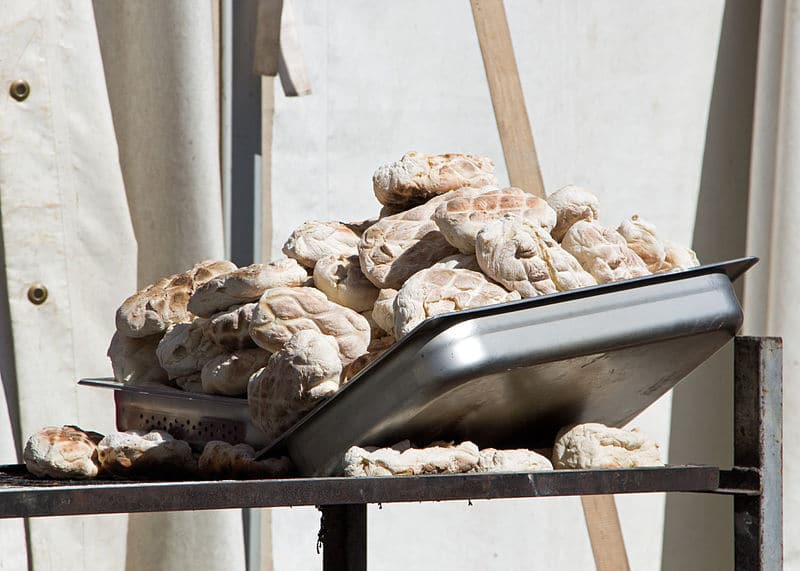
A braaibroodjie or braai bread is the simplest of sandwiches made as a snack to satisfy hungry tummies while waiting for the braai to finish.
It is a simple sandwich made of two pieces of bread, cheese, tomato, onion and salt and pepper. Sometimes chutney can be added. The bread is then thrown on the fire for a short amount of time until the bread is brown and the cheese melted. Simple, easy, delicious.
Roosterkoek (grilled caked) on the other hand is a thick bread ball of dough that is chucked on the burning coals until ready and eaten straight off the flames and piping hot.
Pap en sous
A great accompaniment to any South African dish is pap en sous, a traditional South African food made from mielie meal (corn) and which is similar to polenta, or the Macedonian kakamak. Sous is the Afrikaans word for sauce, but this is a warm sauce made from tomatoes, onions and spices.
While the meal can be prepared on a pan in the kitchen, it’s best to throw your cast iron pan on the braai and cook it there.
Bobotie
Bobotie is possibly the best representation of South Africa’s Cape Malay culture. It’s a simple dish made with spiced and baked minced meat topped with an egg mixture.
While its origins are contentious, it’s said that the meal was brought in by the Dutch and then spiced up by the Malay and Indonesian slaves who added curry powder and other spices like turmeric, coriander and cumin.

Many people believe that the word derived from bobotok or botok, an Indonesian dish made using coconut flesh, vegetables and meat, cooked in a banana leaf.
It’s sort of like a meatloaf or Shepard’s pie, but instead of mashed potatoes on top, you get a lightly crusted egg mixture. Chutney is usually added either in the mince or after for a sweet, fruity kick.
Bunnychow
No, bunnychow is not a South African dish made from or for rabbits, in fact the very first bunnychow was vegetarian.
No one really knows where the name came from, but there are many anecdotes that are quite fun. Possibly it’s because you eat it with your hands, resembling a bunny. Maybe it’s because a man named Bunia started selling it on the street corner. Or could it be that the word “Banya” was used as a synonym for the Indian population in Durban, where it originated. 1
Either way this exceptionally filling meal is made by adding a flavorful curry to an emptied out half loaf of bread. It’s the perfect blend of East (curry) meets West (bread) set in a purely South African context – Indian migrant workers looking for quick and cheap food alternatives. It’s also said that they didn’t have containers, so the loaf of bread worked as a substitute.
Kota
The kota is similar to a bunnychow, the main difference is what’s packed inside. It is a quarter (pronounced kota) loaf of bread that is also hollowed out, yet this time filled with heart-clogging ingredients like atchar, polony (Bologna sausage), fried chips, cheese, egg and Russian sausage.
It is as unhealthy as it is delicious and is one of the most popular South African street foods, especially in the townships.
Gatsby
Just like the two meals mentioned above, the gatsby is not as decadent as the fictional Fitzgerald character, but it sure does pack a punch. Instead of hollowing out a loaf of bread, the gatsby is made using a foot long roll.
The roll is cut in half and the ingredients are added in, usually polony, slap chips (thick cut and soft french fries) and achar. This is more a Cape Tonian food than Durban.
Bredie
Bredie is another Dutch-Malay hybrid brought into the country by the Malay and then adapted to the Dutch palate. It is a thick and hearty slow cooked stew and the perfect South African dish for a cold winter’s day. The most popular bredie is of the tomato variety.
It is usually packed with mutton or lamb and vegetables like cabbage, green beans, pumpkin or waterblommetjies (Cape water lily).
The Afrikaans word bredie possibly comes from the Indo-Portuguese bredo meaning “edible greens” which describes the waterblommetjie used in the dish. The edible flower is actually used as an ingredient for other South African meals like potjie. There’s even a Waterblommetjie Festival held annually.
Mashonzha
The Mashonzha or Mopane worms have provided those living under the poverty line a much needed source of protein for decades. In fact they contain 60% protein as well as phosphorus, iron and calcium.
After being harvested, the innards of the worms are removed and then the rest of the worm is dried out in the sun or boiled in salt water and then preserved. They have an incredibly long shelf life and can be stored for up to a year.
They are usually eaten as a snack or cooked into a stew. You will not find them in any stores or restaurants and will most likely only find them in African communities.
Frikkadels
Frikkadels are a traditional Afrikaner food. These little bundles of joy are basically meatballs that are usually fried in a pan filled with butter. They are made with mince beef, onion, bread, eggs, vinegar and spices.
Frikkadels are best served hot with a side of potato wedges and a tomato-based gravy. They are the perfect snack food if you don’t have much time as they take about 10mins to make.
Some secrets to the perfect Frikkadel: mix the mixture gently with two forks to make the balls softer. The higher the fat of the mince, the juicier the balls. The bread crumbs can also be moistened with milk before adding the mince. And lastly the ingredients need to be chopped finely otherwise your meatballs may fall apart mid fry.
Biltong, Droewors & bokkom
Biltong is unofficially South Africa’s favorite snack. They are unprocessed and cured meat strips that are similar to the US’s beef jerky or the Chinese bakkwa.
The snack was originally invented by the indigenous people of South Africa, the Khoisan, probably in the 1600s. Although the meat was cured at that time, it wasn’t spiced like it is today. The addition of spices and vinegar came with the European settlers, along with more sophisticated curing processes.
Due to its enduring nature, it was a popular snack to take on journeys across the ocean and was enjoyed by the Voortrekkers too.
Biltong uses lean protein, so it does have some health benefits, although the salt used for curing may throw the health balance off. The most popular meat to use is beef, although game is also very popular, particularly kudu, springbok and wildebeest, and ostrich.
Droewors is biltong in a sausage form and is usually crisper and a bit drier than its cousin. Bokkom is the fish version of biltong and is an incredibly salty yet quite addictive snack. The smell, as you can imagine, is quite intense.
While biltong and droewors can be bought at almost any shop or convenience store in the country, the best place to go for bokkom is up the West coast of Cape Town in Velddrif as they produce 95% of bokkom in South Africa.
There is not much else in this sleepy fishing village other than a few restaurants serving delicious seafood, but it’s a great pop in if you’re visiting Cape Town’s West Coast like Saldanha Bay, Elands Bay or the West Coast Nature Reserve.
Vetkoek or Amagwinya
View this post on Instagram
Vetkoek or “fat cake” is the perfect blend of sweet, salty and savory. Imagine a doughnut without the hole, cut in half and filled with a mix of mince, syrup, honey or jam. Now you know the taste of this delicious South African treat.
This fried dough bread snack that is similar to the Caribbean Johnny cake, Dutch oliebol, and Mexican sopaipillas, is usually served alongside boerewors at a traditional South African braai.
In the townships it is called amagwinya and sold at spaza shops (informal convenience shop) or roadside vendors.
Denningvleis
View this post on Instagram
Another Cape Malay dish, denningvleis is a hearty meat stew blended with bay leaves and either tamarind or lemon juice, and is usually served with rice and roasted veg. The name is derived from the Javanese “dendeng” which is the meat of the water buffalo, vleis is “meat” in Afrikaans.
Although the original Javanese dish used water buffalo, the South Africans adapted it and now use mutton. Apparently, denningvleis was used to increase acidity levels in the body back in the day. It is a taste sensation that bounces between sweet and sour with the melt in your mouth lamb.
Meals with fish and seafood
With all this hearty and meaty food in South Africa, it’s nice to have a break once in a while and opt for the lighter fish. SeaHarvest, one of South Africa’s major fishing businesses, states that out of the 310 million kgs of fish that South Africans eat annually, only 50% is locally caught.
They go on to say that the freshest fish you will find in the country would be in the Western Cape region as over 94% of the fish caught by South African deep-sea trawlers comes from this province.
The most popular fish, due to its abundance and lower price, is hake with over 144,000 tonnes caught annually. When the menu at a restaurant says “fish”, it will most likely be hake, which is similar to cod (kabeljou in Afrikaans) and haddock.
The most typical South African meal you can have with hake is “fish and chips” (just like the British version).
This is battered and deep fried hake along with a side of slap chips. The chips usually come without spices or condiments, and you will have to add those later. The best local mix is salt, vinegar and tomato sauce.
If you don’t want the caloric-fueled deep fried version, you can usually ask for it to be grilled. Other popular fish are kingklip, yellow tail, kabeljou (dusky kob), and cape salmon.
Another local favorite, and Saldanha Bay’s most unique export, is snoek. It’s an oily, boney, flaky fish with a distinctly fishy flavor. Weskus snoek (West Coast snoek) can be bought fresh and thrown on the braai. Yet the most popular version is the smoked snoek which can be bought at just about any supermarket in the Western Cape and beyond.
South Africans also love their seafood platters which usually include line fish (catch of the day) or hake, calamari rings, squid heads and tentacles, muscles in a cream sauce and prawns. The platter usually also comes with a side of starch and steamed veg. You can have the seafood deep fried, like they do in Argentina food, or grilled, and you can also ask for half chips and half rice if you can’t choose.
Perlemoen, also known as abalone, is becoming scarce in the country due to the massive abalone poaching industry that runs between South Africa and China. If you do see abelone on the menu, it is most likely farmed and not from the open seas.
Crayfish is also very popular to throw on the braai, and seafood potjie is absolutely wonderful.
Pro tip: Some of the best seafood restaurants in the Cape include Trawlers in Gordon’s Bay, Fish on the Rocks in Hout Bay, Kalky’s in Kalk Bay, and if you travel up the West Coast, Strandkombuis in Yzerfontein.
Umngqusho (samp and beans)
View this post on Instagram
Umngqusho is an African dish made with samp (crushed mealie kernels) with a blend of sugar beans, butter, onions, potatoes, chillies and lemons that simmer together until soft and bursting with flavor.
There are also other variants like the one made with mielie-meal, semolina and peas or apparently Nelson Mandela’s favourite dish, the Xhosa version served with butter or fat. It’s also called isistambu in Zulu. It is a staple food in the African communities, particularly the Nguni tribes.
Umphokoqo (pap and fermented milk)
View this post on Instagram
Another staple in the African community is umphokoqo, also known as African salad and another of Madiba’s favorites.
It is a simple side dish of crumbled maize meal and usually served with Amasi (fermented milk) on the side that tastes similar to cottage cheese or yoghurt. Other than eating it straight up, umphokoqo can also be served along with stews.
Chakalaka
View this post on Instagram
Not so much a meal than a relish, chakalaka is a spicy vegetable accompaniment to bread, pap, samp, stews, or curries. It’s origins are believed to come from Mozambican mineworkers, who cooked tinned produce such as tomatoes and beans with chili. This shows the Portuguese influence as Mozambique was a Portuguese colony.
Today there are as many variations of chakalaka as there are families who make it. Some use onion and garlic, while others use curry paste and cabbage. It can also be found in all major supermarkets in the canned goods section.
Cape Malay & Durban curry
View this post on Instagram
As explained above, the Cape Malays have a unique history in South Africa. If you want to venture into the past of their culinary offerings, the best thing is to book a food tour through Bo Kaap just above Cape Town’s Central Business District.
You can book a Bo Kaap cooking class on Getyourguide here. With this class you will learn how to cook traditional Malay meals with a local in Bo Kaap! The area is famous for its colorful houses, beautiful mosques and vibrant Muslim culture. Atlas Trading Co. in Bo Kaap is an institution and sells every spice you can imagine at affordable prices.
One of the most popular meals to come out of Bo Kaap is the Cape Malay curry. While this is an umbrella term for various different kinds of curry, the traditional method uses lamb that is slow cooked until tender. Many different spices are thrown in, from coriander and cumin to turmeric and cinnamon.
View this post on Instagram
Durban curry is similar to the Cape Malay one but has a few more ingredients and tends to be spicier than the sweeter Cape style. Here is a table of the ingredients in the different curries, so that you know more clearly the similarities.
Sosaties
Sosaties are South Africa’s answer to Southeast Asia’s satay. It is a simple marinated meat (usually lamb) on a skewer with vegetables and fruit at random intervals between the meat, shish-kebab style.
The most common items for a sosatie, between the meat cubes, include red onions, mixed bell peppers, prunes and dried apricots. Chicken or beef can also replace the lamb. Just like satay, the skewers are thrown over hot coals until ready.
Chutney
South African’s love their sauces. From tomato to Worcester, a meal is not complete until some form of thick juicy liquid is thrown on top.
South Africa fruit chutney is thick, tangy and sweet and was popularised by the Cape Malay. While many roadside farm stalls (padstalle) have their own artisanal chutneys made from all types of fruit, the most popular brand which has gained international fame is Mrs. Balls. The peach flavor is particularly sought after.
Chutney is the perfect relish for oily meats and is also used to add some sweetness when cooking. If you see the word “blatjang” on the bottle, this is just the Afrikaans word for “chutney” (although blatjang is officially smoother and made with sundried apricots and chilis).
Most delicious South African desserts
After adopting the three course meal from Europe, South African’s feel empty if they don’t get something sweet after their meal. Dessert culture is huge in South Africa and there are some extremely delicious traditional South African sweets to try when in the country.
Milktart
Milktart, known as melktert in Afrikaans, is a deliciously creamy custard pie made from eggs, flour, milk and sugar with a sweet pastry crust. There are two versions of the silken dessert, one where the custard is baked in the crust and the other where the custard is made separately and poured into the crust for serving.
The filling therefore differs in consistency from runny to sturdy, but the taste is always a milky sweetness. Cinnamon is usually sprinkled on top and the dish is served cold or hot.
Peppermint Crisp tart
View this post on Instagram
Back in the day, Swiss food conglomerate Nestlé created a delicious treat called Peppermint Crisp. It is thin layers of crunchy candied peppermint covered in a layer of chocolate. Someone with a bit of an adventurous mind thought this would be good as a pudding and the Peppermint Crisp tart was born.
It is an extremely sweet dessert made with fresh cream, Bakers Tennis Biscuits (another popular South African teatime snack), caramel and of course Peppermint Crisp chocolate. The ingredients are blended together and layered with the biscuit and then stored in the fridge for an hour.
It is served cold with some cream on the side to counteract the sugary explosion.
Pro tip: When I was young, my friends and I loved to bite the chocolate off the ends of the bar and then use the hollow peppermint filling of the Peppermint Crisp as a straw to drink milk. You can try it for yourself as the chocolate is available anywhere in the country. Good luck trying to get the peppermint candy off your teeth though, it’s crazy sticky!
Asynpoeding
View this post on Instagram
Asynpoeding, or in English vinegar pudding, doesn’t sound too appetizing, but you can trust the South African’s to find a way to make even vinegar into a deliciously sweet dessert.
Similar in texture to malva pudding, this treat is a spongy and buttery cake made with vinegar which creates an appealing acidity that counteracts its robust sweetness. It has its roots in wine pudding, but someone substituted wine for vinegar along the way.
Koeksisters & Koesisters
Take some plaited dough, deep fry it, then chuck it in some ice-cold syrup and you will have the sugar bomb known as a koeksister. While the koek part of the name means cake, the sister part is contentious. It most likely has something to do with the plaiting which sisters might do with their hair.
Apart from sticky fingers, when you bite into the koeksister you get a crisp outer coating and a delectably soft inside making it slightly chewy.
While the koeksisters are of Dutch origin, their smaller relatives, the koesisters are Cape Malay. So of course it is more spicy than sweet. It is light and fluffy dough sprinkled with cardamom, cinnamon and dried ginger and finished with a dash of desiccated coconut. It is a ball and not a plaited snack.
The best place to find koeksisters is at a padstal, although they are found in any supermarket. The artisanal ones are always the best. Koesisters are more generally found in Cape Town near Bo Kaap along Wale or Rose Streets.
Go on a half day tour of Cape Town and ask your guide to point you in the direction of both the sister snacks!
Malva pudding
View this post on Instagram
This is a personal favorite of mine. Served warm, the spongy texture and sweet apricot jam melt in your mouth and are perfectly accompanied by either custard or ice cream (or both!). Not much more can be said about this cake-like pudding other than go give it a try.
No one knows the clear origin of the name. Some people believe that the inventor was named Malva, others say that it’s derived from the Afrikaans “malvalekker” meaning “marshmallow” which is said to have a similar texture (although I disagree). The most prominent theory is that Malvasia (malmsey) wine was poured into the sauce when it was originally created.
A variant of this is brandy pudding (tipsy tart) which is, as the name suggests, infused with brandy, and Jan Ellis pudding which is similar to malva except it uses baking powder instead of baking soda and vinegar.
Boeber
For the South African version of Southeast Asia’s sago pudding, try a bit of boeber. This dessert came from the first slaves who were brought from Indonesia and Malaysia and is a truly Cape Malay dish. It has a similar name to the Malaysian bubur lambuk which is eaten to break the fast during Ramadan.
It could also have its origins in the Indian indentured workers as it is similar to the Indian kheer. It is a milky blend of vermicelli, sago, sugar, and flavoured with cardamom, a stick of cinnamon and rose water.
Hertzoggies
View this post on Instagram
Hertzoggies are the perfect South African snack to eat at teatime. They are small jam tartlets topped with coconut and usually come in a cup-like shape.
The tartlet gets its name from South African politician, Prime Minister (1924–1939) and Boer War General J. B. M. Hertzog who is said to have loved them. It was also under his leadership that (white) women gained suffrage and were allowed to vote in 1933. His supporters would bake hertzoggies to show their support.
Pumpkin fritters/pampoenkoekies
View this post on Instagram
Pumpkin fritters or pampoenkoekies in Afrikaans are pretty self explanatory. They are small, circular, light and fluffy fritters made from blending pumpkins with flour, sugar and baking powder, egg and milk into a puree and then frying until golden brown and crisp.
They can be round or oval and flat and are usually served with caramel sauce.
The best South African drinks
South Africa is mostly known for its world class wines that are extremely high in quality, especially for their prices. Another popular drinkable export is the caffeine-free rooibos tea, which is found in the Cederberg with 6,338 tons being exported in 2016.
There are few other delicious drinks to come from the country which can be found below.
Mageu and Amasi
Mageu is a traditional Southern African non-alcoholic drink that is popular among many of the African people. It’s derived from the process of fermenting mealie pap (maize meal) and has a very similar consistency to yoghurt.
It is usually enriched with additional vitamins and minerals essential like Vitamins A, B1 (thiamine), B2 (riboflavin), B6 (pyridoxine), B12 (cobalamin), C (ascorbic acid), D, E, and K. So it’s pretty good for you when drunk in small amounts, like yoghurt.
Amasi is a similar drink, except it’s made from fermented milk that tastes like cottage cheese or plain yogurt.
Rooibos tea (and rusks)
Rooibos or red bush tea comes from a naturally caffeine-free plant that has been brewed since before the European settlers arrived. After the Europeans landed in South Africa, they found rooibos as a cheaper alternative to the expensive black tea brought by ship.
The first commercial farms were in Clanwilliam in the Cederberg after Dr Pieter Lafras Nortier found a way to germinate the tiny seeds.
Rooibos is red in color and similar in taste to hibiscus tea. While many South Africans drink it plain, it’s popular to add honey, sugar, milk or a slice of lemon and ginger. The last one is great when you feel the flu coming on.
If you do have the chance to taste Rooibos, do yourself a favor and get some buttermilk rusks, which can be dipped in the liquid until soft and eaten. This is a typical South African tea time snack. It is also made into a “Red Cappuccino” at many coffee shops as an alternative to coffee.
Amarula
This creamy liqueur very similar to Baileys is pretty addictive, especially if you have a sweet tooth. Amarula is made from the fruit of the African marula tree and is blended with sugar and cream. It has an alcohol content of 17% by volume and tastes like liquid fruity caramel.
It’s best sipped on a hot day with some ice.
Wine
South Africa is the ninth-largest wine-producing country in the world. So when you visit the country, be prepared to drink a glass at every meal if you really want to get the full taste profile.
Wine in South Africa began with Jan van Riebeek, who planted some vines in what is today Company’s Garden in central Cape Town with the first grapes pressed in 1652. Later on in 1685 Simon van der Stel (where the name Stellenbosch comes from) planted vines in Constantia.
Groot Constantia is probably the oldest winery in the country and should be on any wine lover’s itinerary. Taste the Grand Constance if they allow you, which is more of a fortified wine. It was sipped by kings and noblemen, like Napoleon, as well as Charles Dickens, Jane Austen and Charles Baudelaire who wrote about this sweet nectar.
After Constantia, grapes were planted in what is now Somerset West by Willem Adriaan van der Stel. You can actually visit his first winery today, Vergelegen, which is a massive property.
Along with the French Huguenots, French wine making techniques were introduced and Franschhoek was born. This should also be on your wine tour stop after visiting the more well known Stellenbosch.
The major grapes cultivars (varieties) grown in South Africa are Chenin Blanc (also known as Steen at 18.2%), Cabernet Sauvignon (11.3%), Colombard (12.0%), Shiraz (10.5%), Sauvignon Blanc (9.4%), Chardonnay (8.0%), Pinotage (7.5%) and Merlot (6.0%).
If you can only try one wine when visiting the country, I would suggest going for the Pinotage, either from Kanonkop or Beyerskloof, as this cultivar is a South African specific creation.
The grape was created by Dr Abraham Izak Perold in 1925 by crossing Pinot noir and Cinsault (or Hermitage). It is also a major component in the Cape Blend red wine, which is basically a Bordeaux Blend with between 30-70% Pinotage.
Many outsiders don’t know, but there are several other lesser known wine routes in the Western Cape such as Riebeek Kasteel, Swartland, Wellington, Paarl, Hemel en Aarde, Botrivier and the list goes on.
Most wineries offer tastings either for a minimal fee or for free. Some wineries also waiver the tasting fee if you purchase a bottle. You do not have to go on a tour to taste wine, and most allow walk ins.
As it is such a competitive field, many wineries have introduced restaurants to their properties or some great pairings. There are even bunnychow (Blaauwklippen) or biltong and wine pairings (Stellenbosch Hills).
You can also send boxes home to your own country at many of the wineries at discounted prices. And while South Aftricans complain about the price of wine, from an outsider’s perspective it is dirt cheap.
Some amazing wines can go for as little as US$5 for a red, but of course they can go up to over US$70. The average price is about US$8-20 for a good red (even some 5* wines on the Platter’s Guide) and a little less for a white.
The greatest part about visiting a winery in the Cape, apart from the historic sites and delicious wines, is the relaxed atmosphere where there is usually a spectacular view or a lawn to sit on and sip your wine (and sometimes have a picnic).
Cocktails
There are a few alcoholic blends that are particularly South African. As we love both our sweets and alcohol, it’s no surprise that we have blended to the two to come up with some amazing concoctions.
The first is a Don Pedro which is basically alcohol added to a milkshake. It started with whiskey, but Amarula, Kahlua and Frangelico are used more often these days. People also call it a Dom Pedro, but the result is always the same, a liqueur-filled milkshake.
Mixology is huge in South Africa. The bar scene is thriving and can be comparable to any of the hip bars throughout the world. Beyond all the smoke and mirrors and fancy cocktails, the original South African shooter is the Springbokkie.
Made from creme de menthe liqueur and Amarula, this is a seriously patriotic shot as it takes its name from the South African rugby team, the Springboks, whose jerseys are gold and green – just like the shooter.
- Check if you need a visa, get help processing it at iVisa.
- Never ever leave without travel insurance. Get affordable coverage from World Nomads or long term insurance from Safety Wing.
- I find all of my flights on KAYAK. Check their Deals section too.
- Search for all your transportation between destinations on the trusted travel booking platform Bookaway.
- I book all my day trips and tours via GetYourGuide, they are the best and their tours are refundable up to 24h in advance.
- Get USD35 off your first booking with Airbnb.
- Compare hotels EVERYWHERE at HotelsCombined and book with Booking.com.
- Compare car rental prices at Rentalcars.com



